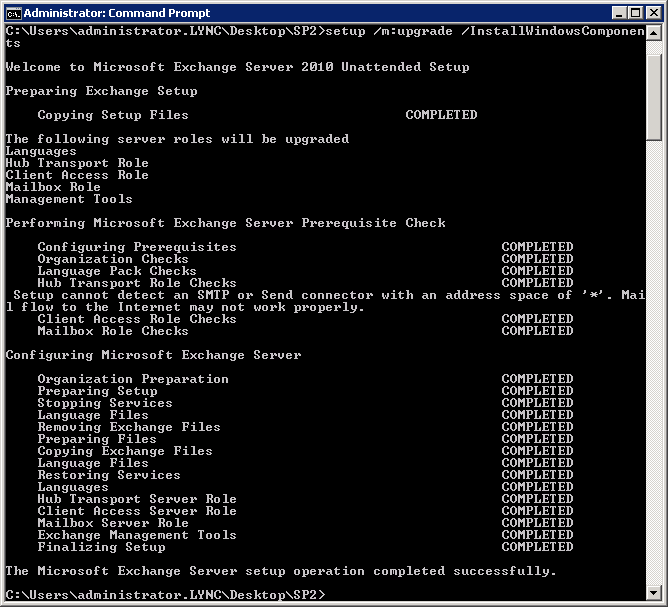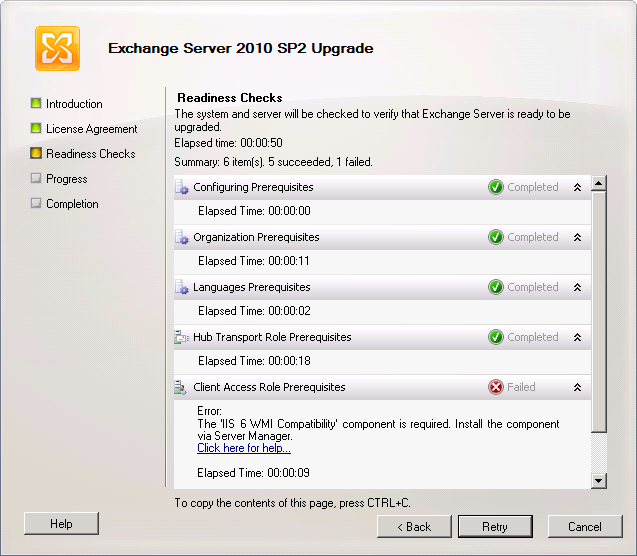Update Rollup 3 (UR3) for Exchange Server 2010 SP2 Released
Microsoft has released the following update rollup for Exchange Server 2010:
- Update Rollup 3 for Exchange Server 2010 SP2 (KB2685289)
If you’re running Exchange Server 2010 SP2, you need to apply Update Rollup 3 for Exchange 2010 SP2 to address the issues listed below.
Remember, you only need to download the latest update for the version of Exchange that you’re running.
Here is a list of the fixes included in update rollup 3:
- 2510607 “Cannot open the free/busy information” error message when you try to view folder permissions in Outlook
- 2514700 Extra.exe does not trace a single user whose legacyExchangeDN attribute contains one or more special characters in an Exchange Server 2010 environment
- 2571342 The Folder contacts list is empty when a user views the properties of a mail-enabled public folder in an Exchange Server 2010 environment
- 2572029 Synchronization of an organizational forms library fails when you use Outlook in Cache mode in an Exchange Server 2010 environment
- 2586828 The EdgeTransport.exe process consumes 100 percent of CPU resources on an Exchange Server 2010 Edge Transport server
- 2589233 Meeting requests bypass the requirement for delegate approval and instead book resource mailboxes automatically in an Exchange Server 2010 environment
- 2633043 “There were no writeable domain controllers found in Active Directory site” error message when you run the ExBPA tool in an Exchange Server 2010 organization
- 2647396 You cannot disable a public folder by using the “Disable-MailPublicFolder” cmdlet in an Exchange Server 2010 environment
- 2648263 You cannot open routing log files on Exchange Server 2010 Hub Transport servers in a mixed Exchange Server 2003 and Exchange Server 2010 environment
- 2667120 MSExchangeAutodiscoverAppPool application pool crashes on an Exchange Server 2010 Client Access server when you try to view the free/busy information about a user in a trusted domain
- 2668900 Event ID 2915 is logged when you apply a fallback policy to a service account in an Exchange Server 2010 environment
- 2670099 You cannot open calendar folders that are shared by hidden users in an Exchange Server 2010 environment
- 2671128 RPC Client Access Cross-Site connectivity issues occur in an Exchange Server 2010 environment
- 2673542 MRM retention policy in the Junk E-Mail folder does not work when you manually move email messages in an Exchange Server 2010 environment
- 2673591 Crash occurs in the Autodiscover application pool in an Exchange Server 2010 environment
- 2674185 MAPI_E_CALL_FAILED errors occur when a MAPI application that uses the MAPI function in Outlook 2007 MAPI or in Outlook 2010 tries to access an Exchange Server 2010 server
- 2674445 You cannot change the access permissions of a Calendar folder in an Exchange Server 2010 environment
- 2677872 You cannot use a distribution group in the hierarchical address book when you create the group in Exchange Server 2003
- 2681250 “550 5.6.0” NDR when a journal report is sent to an external contact in an Exchange Server 2010 environment
- 2682047 You cannot access a mailbox for several hours after you disconnect and then reconnect the mailbox in an Exchange Server 2010 SP2 environment
- 2682408 AddOrganizerToSubject parameter does not take effect when a recurring meeting conflicts with another meeting in an Exchange Server 2010 environment
- 2682895 Error message when a role assignee runs the Get-MailboxExportRequestStatistics cmdlet in an Exchange Server 2010 environment
- 2684583 You cannot delete an empty folder in a .pst file by using Outlook in an Exchange Server 2010 environment
- 2689810 A meeting request that you send from an EWS application is in plain text format instead of HTML format when an attendee opens the request by using Outlook in online mode
- 2695011 Junk Email settings do not work as expected after you migrate or move a mailbox to an Exchange Server 2010 SP1 Mailbox server
- 2695022 The E-mail Signature text box is not editable in Outlook Web App when you use Google Chrome in an Exchange Server 2010 environment
- 2695836 You cannot move a mailbox in an Exchange Server 2010 environment that has a message size limit configured
- 2696642 An additional line of space is added in each paragraph in an email message when you click the Printable View icon in Outlook Web App in an Exchange Server 2010 environment
- 2698927 Resource mailbox that has AutoAccept configured does not process a meeting request that contains custom code or script in Exchange Server 2010
- 2698960 You cannot move some users’ mailboxes from one Exchange Server 2010 mailbox database to another
- 2698976 Managed Folder Assistant does not process a mailbox that has external contacts in another tenant organization in an Exchange Server 2010 environment
- 2699023 Event ID 9646 is logged on the Exchange Server 2010 mailbox server when you access a mailbox that has more than 250 folders by using an IMAP4 client
- 2699577 GAL-related client-only message rule is not applied in Outlook after you apply RU1 for Exchange Server 2010 SP2 in an Exchange Server 2010 environment
- 2699582 Error message when you play a voice mail by using Outlook 2007 in an Exchange Server 2010 environment
- 2700544 Multiple recovery items are added to a subfolder of the Recoverable Items folder in an Exchange Server 2010 environment
- 2705425 UMWorkerProcess.exe consumes large amounts of memory when you try to listen to voice messages by using Outlook Voice Access in an Exchange Server 2010 environment
- 2705555 The Set-Mailbox cmdlet takes a long time to complete configuration in an Exchange Server 2010 environment
- 2705570 An error occurs when a user whose mailbox is hidden from the Exchange address list tries to open the Scheduling Assistant tab by using the light version of Outlook Web App
- 2705647 A user cannot log on to a mailbox that is full by using Outlook Web App in an Exchange Server 2010 environment
- 2705682 Post-reform spelling rules are not used in the Portuguese (Portugal) dictionary in Outlook Web App in an Exchange Server 2010 environment
- 2706523 You cannot create a mailbox or mail-enable a mailbox for a disabled user account in an Exchange Server 2010 environment
- 2708880 You cannot set the “Country/region” attribute of a user mailbox to “Curaçao,” “Bonaire, Sint Eustatius and Saba,” or “Sint Maarten (Dutch part)” by using the Exchange Management Console on an Exchange Server 2010 server
Download the rollup here.
Installation Notes:
If you haven’t installed Exchange Server yet, you can use the info at Quicker Exchange installs complete with service packs and rollups to save you some time.
Microsoft Update can’t detect rollups for Exchange 2010 servers that are members of a Database Availability Group (DAG). See the post Installing Exchange 2010 Rollups on DAG Servers for info, and a script, for installing update rollups.
Update Rollups should be applied to Internet facing Client Access Servers before being installed on non-Internet facing Client Access Servers.
If you’re installing the update rollup on Exchange servers that don’t have Internet access, see “Installing Exchange 2007 & 2010 rollups on servers that don’t have Internet access†for some additional steps.
Also, the installer and Add/Remove Programs text is only in English – even when being installed on non-English systems.
Note to Forefront users:
If you don’t disable Forefront before installing a rollup or service pack, and enable afterwards, you run the risk of Exchange related services not starting. You can disable Forefront by going to a command prompt and navigating to the Forefront directory and running FSCUtility /disable. To enable Forefront after installation of a UR or SP, run FSCUtility /enable.








Follow Me